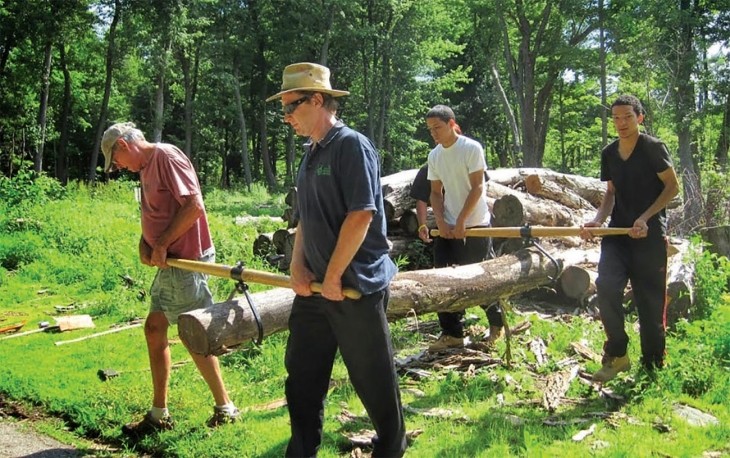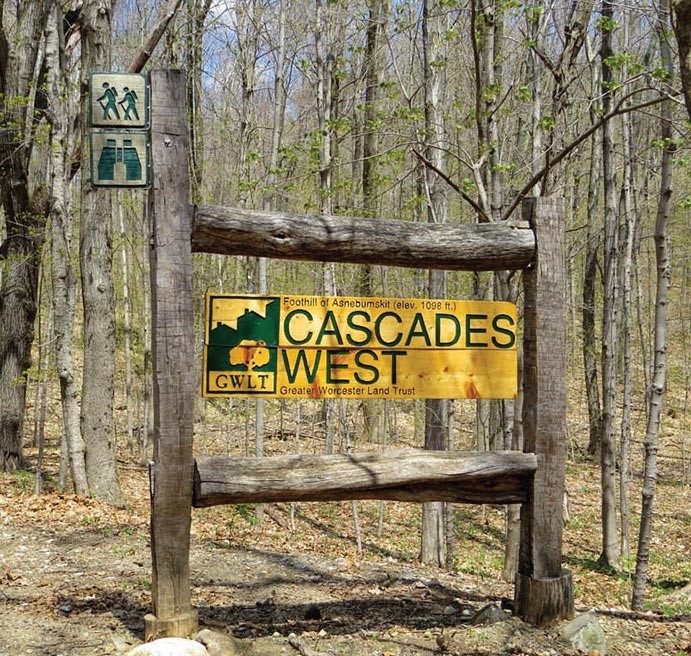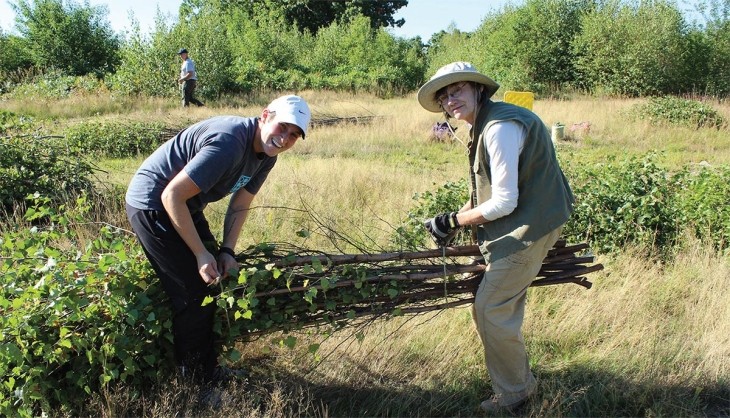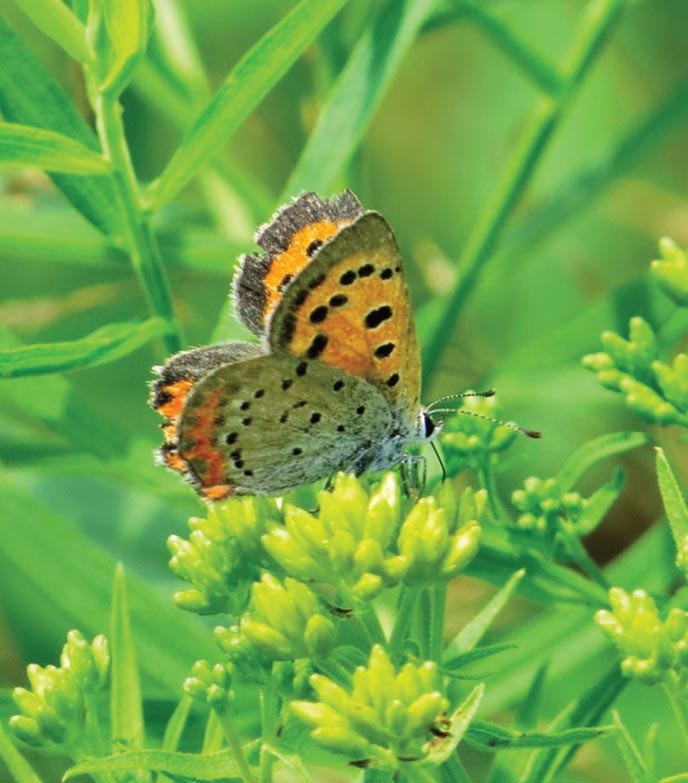Back in 1997, the state forester reviewing a habitat improvement grant application for a property on the northwestern edge of Worcester, Massachusetts, remarked that the proposal was “a little too small, a little too close to the urban edge, but what the heck, there was absolutely public educational value.” More than two decades later, with hundreds of hours of labor and volunteer effort to restore the property, that leap of faith resulted in a local birding hotspot and a place of pride for the Greater Worcester Land Trust (GWLT).
Skepticism wasn’t the only challenge the project faced. The site, known as Cascades West Conservation Area, encompassed an abandoned hilltop farm-field reclaimed by white pine. As compared to Worcester’s open parks and athletic fields, this dense, dark pine grove seemed like an old growth forest and a refuge. The proposal of removing the declining white pine grove and cutting back the thick Norway maple understory made silvicultural sense but it was an emotional hurdle.
The Trust’s forester, Roger Plourde of Broad Arrow Forestry, explained the habitat benefits for wildlife and the positive impacts of removing invasive exotic species to GWLT staff and board members. Initially, the visual aspect of removing the coniferous stand – so unlike anything in the surrounding area – was viewed by the Trust as a loss. Plourde described an equally distinctive and appealing future habitat: a low meadow with berries to be picked, full of birds and other wildlife, all at the edge of the city. With a vision of baskets of berries, and the potential for more diverse wildlife at the site, the Trust agreed.
Cascades West was already open to the public, with a hiking trail system and a trail running straight through the project area and its pine grove. While GWLT was now convinced that replacing the pine grove with meadow habitat was the right thing to do, the next step was to convince the hiking public, and to prepare everyone for the detours and disruption that were about to happen. The Trust installed a 4-foot-by-4-foot sign describing the project, its goals, and the specific treatments and practices. The Trust staff accompanied reporters from the local newspaper on a tour of the property, and the Trust informed its members of the change through its organizational newsletter.
In 2000, the initial cut was made. It was primarily a firewood operation, logged by a small local outfit under a state Stewardship Incentive Program (SIP) grant. During the course of two winters, the most mature Norway maple was cut back, and the white pine stand became a forest opening. The public did not protest or complain. Every few months, GWLT staff took panorama shots from the property and posted them online. Hikers remarked on it. Birders came to it.
Follow-up maintenance to the forest cuts became a popular GWLT volunteer activity. During the course of the year, volunteers collected broken limbs and branches and placed them in piles. In the winter, the Trust obtained a town permit for a brush pile burn, borrowing some old backpack fire pumps from the local scout camp. Board members, staff, and volunteers gathered for the burn, as well as for a feast of hotdogs and marshmallows, and passing hikers joined in. These annual brush pile burns continued for several years, until the number of branches from the cuts were reduced, and the regrowth at the site continued.
The stand came back into a dense early successional growth, some of it good, some of it not so good. The grant didn’t allow for the costs of taking out the stumps, so mowing wasn’t going to be easy. Some early efforts were made with a small walk-behind brush mower, but progress was slow for a lot of work and eventually was abandoned as a practice. Also, more ominously, Norway maple saplings dominated the understory. The mature Norway maple may have been cut, but there needed to be follow-up treatment.
Serious maintenance activity returned to the site in 2005, when GWLT received a state Landowner Incentive Program (LIP) grant. The stumps had begun to break down naturally, and it was determined that a forestry mower could reopen the field, take out the tops of the stumps, and leave it ready for conventional mowing with a brush hog. In contrast with the two years of a small outfit logging, this process took the forestry mower about two days.
The results were gratifying. After a decade of planning, cuts, winter brush pile burns, and grant paperwork, there was at last a mow-able meadow! In celebration, GWLT had the field mowed with a brush hog in the fall of 2006 and held a “Dinner in the Meadow” for volunteers and members. A long table was set, tablecloth unfurled, pheasants roasted, candles and bonfire lit, and at dusk dinner was served.
The second prong of the 2005 project focused on chasing down the young Norway maple understory ever deeper into the forest. In this effort, GWLT experimented with a Sproutless attachment to two Stihl brush saws that left a limited dose of herbicide on the cambium layer of the cut stumps. This worked, to an extent, but the setup process was complicated. The understory was improved but not free of the invasive tree. The site was allowed to regrow.

In 2012, GWLT received a USDA Natural Resources Conservation Service Wildlife Habitat Improvement Program (WHIP) grant to continue the Cascades West forestry work. As part of the application process the grant asked if the past practices were successful. Anecdotally, everyone was happy with the reduced invasive tree population, and the early successional meadow was attracting all kinds of wildlife including bear, but that wasn’t really answering the question. Birds were the original indicator species. Was the bird habitat projected in the original plan realized?
GWLT staff turned to the “usual suspects” among local birders to help them determine if the site was attracting the original list of key indicator species. A central question was, did they even know about the field? It turns out that they not only knew about the field, but it had become a regular hot spot; there were specific bird lists just based on the location. While GWLT didn’t know it, the project had fully succeeded, and the target species had returned!
Since 2012, GWLT has continued to put time and work into Cascades West and to find new ways to nurture use and stewardship of the property. For example, in 2016, it happily furnished Patrick Dougherty, a visiting artist at College of the Holy Cross, with Norway maple saplings for his woven sculptures. The site has also provided saw logs, firewood, and wood chips. GWLT has harvested black locust for signposts, fence posts, and erosion control water-bars. Sugar maple trees have been tapped for syrup. Raspberries and mushrooms have provided forage. Out of a leap of faith – and two decades of hard work, outreach, and monitoring – grew a healthier forest and an early successional habitat with abundant signs of wildlife and a connected community.




